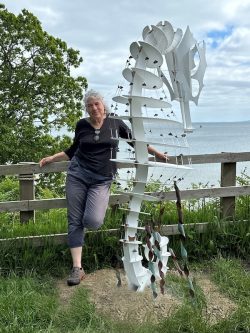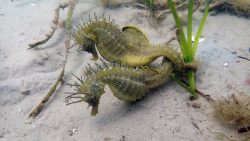 SEAHORSES are enchanting, magical creatures – but they are vulnerable to many forces, human and natural. There is an important but fragile population ion Britain’s two native seahorse species – the spiny and short snouted seahorse – in the Studland seagrass meadow, which itself is a threatened habitat.
SEAHORSES are enchanting, magical creatures – but they are vulnerable to many forces, human and natural. There is an important but fragile population ion Britain’s two native seahorse species – the spiny and short snouted seahorse – in the Studland seagrass meadow, which itself is a threatened habitat.
The meadow is a voluntary no-anchor zone and eco-moorings are in place to allow boaters to enjoy the area without having to anchor and destroy the seagrass, which provides a safe place and nursery ground for many species to live and reproduce. It also acts as a filter, trapping sediment, nutrients and pollutants which dramatically improve water quality and can mitigate against climate change. Globally, seagrass accounts for 10-18% of total ocean carbon storage despite covering less than 0.1% of the seafloor.
Seagrass meadows in the UK have declined significantly over the last century, due to a combination of factors including climate change, heightened storms and anchoring. The sheltered conditions of Studland Bay allow the seagrass to thrive and means it’s a popular anchorage for boat users. Anchors and traditional moorings damage the root structure of seagrass, leading to anchor scars and fragmentation of the habitat which can take years to recover.
 A new artwork, an abstract, giant seahorse has been installed at Middle Beach in Studland Bay. The sculpture, named Neptune, was created by artist Eilidh Middleton to highlight the importance of seagrass at Studland Bay and its loss around our coasts in the UK.
A new artwork, an abstract, giant seahorse has been installed at Middle Beach in Studland Bay. The sculpture, named Neptune, was created by artist Eilidh Middleton to highlight the importance of seagrass at Studland Bay and its loss around our coasts in the UK.
Sarah Coggins, the National Trust’s coastal change engagement officer, says: “Seagrass has superpowers. It creates biodiverse hotspots that not only support our seas but the climate too. We’re grateful for Eilidh Middleton for installing such a stunning seahorse sculpture to help create awareness of the need to protect our marine environment here at Studland Bay.”
Studland’s seagrass is protected within a Marine Conservation Zone and the Studland Bay Marine Partnership (SBMP) was created to bring together conservation and boating organisations, academics and community groups to find a solution that meets the needs of the public and recreational boaters while protecting and restoring the sensitive seagrass habitat.
Following consultation by the Marine Management Organisation (MMO), it was concluded that conservation management measures needed to be developed in Studland Bay, and the Voluntary No Anchor Zone (VNAZ) came into effect in 2021. In 2024 SBMP, with the help of the Ocean Conservation Trust, installed VNAZ marker buoys at Studland Bay to outline the seagrass meadow below. The SBMP also secured funding through grants and donations to take the total of eco-moorings available to 87 in the bay.
These enable boaters to enjoy the area, without conventional anchoring. Eco-moorings use a helical screw which is secured into the seabed and an elastic rode connected to a buoy which sits on the surface. The elastic rode will stretch at higher tides and contract at lower tides, so the equipment does not damage the surrounding seagrass.
Neptune the seahorse is made entirely from material from the artist’s previous work, including the 200-meter-long Sand Lizard installed on the mound of Corfe Castle last year. Neptune, who stands proud at 2.2 metres tall, will be at Middle Beach until the end of summer.
To coincide with the installation, the National Trust team at Studland Bay has created a fun family quiz trail, running to Sunday 1st June. Starting at Knoll Beach, families are taken along a route of fun and educational posts relating to seahorses, and ending at the sculpture.
Free quiz trail | Saturday May 25 – Sunday June 2 | Starts at Knoll Beach | Car park open 8:30am – 8pm
Photographs: Seahorses, © Neil Garrick-Maidment The Seahorse Trust; artist Eilidh Middleton with Neptune the Seahorse at Studland Bay, © National Trust, Fleur Castell